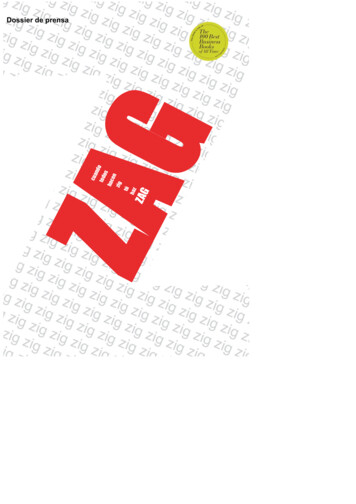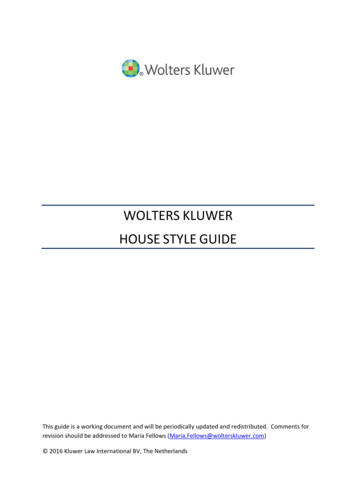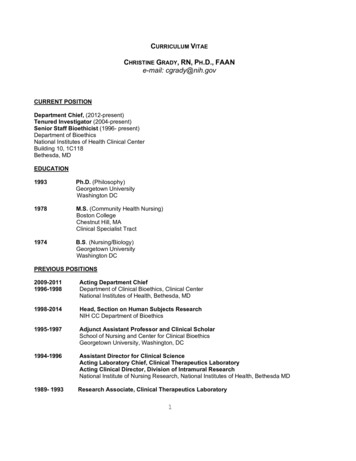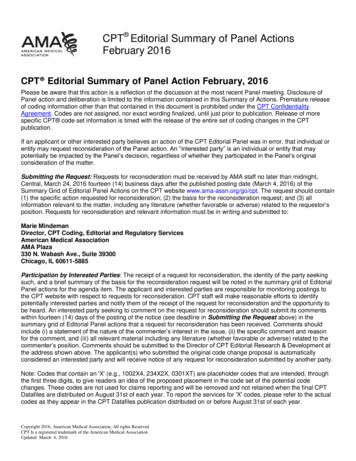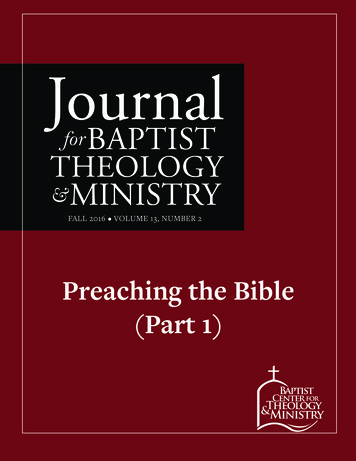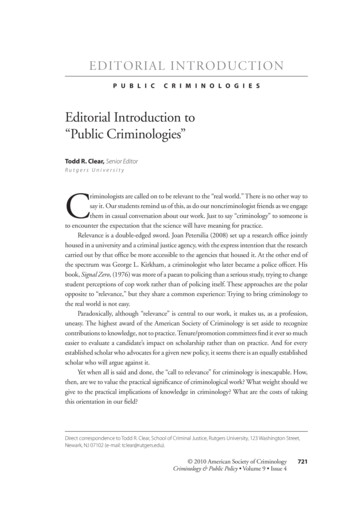
Transcription
Editorial IntroductionP u b l i cC r i m i n o l o g i e sEditorial Introduction to“Public Criminologies”Todd R. Clear, Senior EditorRutgers UniversityCriminologists are called on to be relevant to the “real world.” There is no other way tosay it. Our students remind us of this, as do our noncriminologist friends as we engagethem in casual conversation about our work. Just to say “criminology” to someone isto encounter the expectation that the science will have meaning for practice.Relevance is a double-edged sword. Joan Petersilia (2008) set up a research office jointlyhoused in a university and a criminal justice agency, with the express intention that the researchcarried out by that office be more accessible to the agencies that housed it. At the other end ofthe spectrum was George L. Kirkham, a criminologist who later became a police officer. Hisbook, Signal Zero, (1976) was more of a paean to policing than a serious study, trying to changestudent perceptions of cop work rather than of policing itself. These approaches are the polaropposite to “relevance,” but they share a common experience: Trying to bring criminology tothe real world is not easy.Paradoxically, although “relevance” is central to our work, it makes us, as a profession,uneasy. The highest award of the American Society of Criminology is set aside to recognizecontributions to knowledge, not to practice. Tenure/promotion committees find it ever so mucheasier to evaluate a candidate’s impact on scholarship rather than on practice. And for everyestablished scholar who advocates for a given new policy, it seems there is an equally establishedscholar who will argue against it.Yet when all is said and done, the “call to relevance” for criminology is inescapable. How,then, are we to value the practical significance of criminological work? What weight should wegive to the practical implications of knowledge in criminology? What are the costs of takingthis orientation in our field?Direct correspondence to Todd R. Clear, School of Criminal Justice, Rutgers University, 123 Washington Street,Newark, NJ 07102 (e-mail: tclear@rutgers.edu). 2010 American Society of CriminologyCriminology & Public Policy Volume 9 Issue 4721
Editor ial I ntroduc tionPublic Cr iminologiesThese questions come under consideration in the lead article by Christopher Uggen andMichelle Inderbitzin (2010, this issue), titled “Public criminologies,” and they are furtherexplored in the series of policy essays.Public criminology is a term used by Uggen and Inderbitzin (2010), rephrasing MichaelBuroway, to refer to the call for criminologists to write and conduct studies in a way that engages the crime/justice consumer publics (both those who make crime policy and those whoare affected by it) in the meaning of the work. This entails talking to, talking with, and talkingabout those publics in the production of criminological scholarship. Public criminologists situatetheir work in the so-called real world, and they orient their productivity to the way in whichthe “the real world” needs it in order to be able to use it.Uggen and Inderbitzin (2010) open the article by describing how the taxonomy of sociological practice that Buroway (2005) laid out in his presidential address to the AmericanSociological Association applies well to the field of criminology. They then go on to describehow particular attributes of criminology—in particular the distinctly public nature of crimepolicy and those close links of criminology to practitioner applications—support the relevanceof public criminology as an idea. They review citations of criminological scholars in the newsmedia as but one of many indications that there is a public hunger for criminologists to helpinterpret the meaning of science about crime and to interpret crime and justice in the news.They show that the work of some of the founding scholars in our field was deeply connectedto a public agenda and broadly consistent with the framework of public criminology. The concluding section of the article identifies some of the problems confronting both the practice ofpublic criminology and the people who embrace that orientation to their work. Some of theseproblems originate because public criminologists generally do their work from a university orcollege base, where there is an uneven appreciation of the contribution arising form this work.Some of these problems come from the inherently contentious nature of policy making andcommunity engagement.Uggen and Inderbitzin’s (2010) article can be perceived as not so much a call for the practiceof a “more” public criminology but as a call for a greater recognition of this kind of criminologyas legitimate and important within the field. By pressing for a greater understanding of the placeof public criminology in the array of orientations within the profession, Uggen and Inderbitzin(2010) hope that the value of public criminology can be enhanced.Ian Loader and Richard Sparks, whose recent book, Public Criminology? (2010), is a detailedexploration of some of these same themes, are cautiously upbeat about the advent of publiccriminology. In their policy essay (2010, this issue) to Uggen and Inderbitzin, Loader andSparks revisit the political and social contexts that make the practice of public criminology notonly difficult but also important. They describe the invaluable resource a social scientist bringsto crime and justice policy: honesty about the evidence and a more thorough understandingof the complexity of the problem. Surely, they point out, honesty and knowledge are essentialelements for an improved public policy regarding crime.722Criminology & Public Policy
ClearPaul Rock (2010, this issue) and Michael Tonry (2010, this issue), writing separate policyessays, are two lauded criminologists who have done a great deal of their work in the publicarena. They are less sanguine about the prospects of public criminology, although not necessarily opposed to it as a form of practice. Both bemoan the regrettable nature of contemporarycrime policy for its many injustices and its often overwhelming foolishness. They attribute thisin large part (with different examples) to the deeply intractable political forces that undergirdthe creation of crime and justice policy, and to the circumstantial ways in which policy changesoccur. Rock adds his own concerns about the ways the criminological enterprise, when it engagesthe public agenda, are subject to being hijacked by the baser aspects of that agenda.The two final essayists, Daniel Mears (2010, this issue) and Kenneth C. Land (2010,this issue), accept as largely self-evident the idea that public criminology is an orientation ofvalue. They offer suggestions in support of the endeavor. Mears identifies ways that the mostproblematic collateral consequences of public criminology can be minimized. Land suggestspotential strategies for institutional support for the practice of public criminology.It would be a misleading reading of these essays as evidence that public criminology “ishere to stay.” Clearly, it has always been with us. The question really is as follows: “What shallwe make of public criminology?” This is true not just among us criminologists but also amongthe larger world in which our work occurs.ReferencesBuroway, Michael. 2005. For public sociology: Contradiction, dilemmas and possibilities.American Sociological Review, 70: 4–28.Kirkham, George L. 1976. Signal Zero. Philadelphia: JB Lippincott.Land, Kenneth C. 2010. Who will be the public criminologists? How will they besupported? Criminology & Public Policy. This issue.Loader, Ian and Richard Sparks. 2010. Public Criminology? New York: Routledge.Loader, Ian and Richard Sparks. 2010. What is to be done with criminology? Criminology &Public Policy. This issue.Mears, Daniel P. 2010. The role of research and researchers in crime and justice policy.Criminology & Public Policy. This issue.Petersilia, Joan. 2008. Influencing public policy: An embedded criminologist reflects onCalifornia prison reform. Journal of Experimental Criminology, 4: 335–356.Rock, Paul. 2010. Comment on “Public Criminologies.” Criminology & Public Policy. Thisissue.Tonry, Michael. 2010. “Public Criminology” and evidence-based policy. Criminology &Public Policy. This issue.Uggen, Christopher and Michelle Inderbitzin. 2010. Public Criminologies. Criminology &Public Policy. This issue.Volume 9 Issue 4723
Editor ial I ntroduc tionPublic Cr iminologiesTodd R. Clear is Dean of the School of Criminal Justice at Rutgers University. In 1978, hereceived a Ph.D. in criminal justice from The University at Albany. Clear has also held professorships at Ball State University, Rutgers University, Florida State University (where he was alsoAssociate Dean of the School of Criminology and Criminal Justice), and John Jay College ofCriminal Justice (where he held the rank of Distinguished Professor). He has authored 12 booksand more than 100 articles and book chapters. Clear has served as president of The AmericanSociety of Criminology, The Academy of Criminal Justice Sciences, and The Associationof Doctoral Programs in Criminology and Criminal Justice. His work has been recognizedthrough several awards, including those of the American Society of Criminology, the Academyof Criminal Justice Sciences, The Rockefeller School of Public Policy, the American Probationand Parole Association, the American Correctional Association, and the International Community Corrections Association. Published studies list Clear as among the most frequently citedcriminologists in America. He was the founding editor of the journal Criminology & PublicPolicy, published by the American Society of Criminology.724Criminology & Public Policy
Research ArticleP u b l i cc r i m i n o l o g i e sPublic criminologiesChristopher UggenUniversity of MinnesotaMichelle InderbitzinOregon State UniversityResearch SummaryPublic scholarship aspires to bring social science home to the individuals, communities,and institutions that are its focus of study. In particular, it seeks to narrow the yawninggap between public perceptions and the best available scientific evidence on issues of publicconcern. Yet nowhere is the gap between perceptions and evidence greater than in the study ofcrime. Here, we outline the prospects for a public criminology, conducting and disseminatingresearch on crime, law, and deviance in dialogue with affected communities. We presenthistorical data on the media discussion of criminology and sociology, and we outline thedistinctive features of criminology—interdisciplinarity, a subject matter that incites moralpanics, and a practitioner base actively engaged in knowledge production—that push theboundaries of public scholarship.Policy ImplicationsDiscussions of public sociology have drawn a bright line separating policy work fromprofessional, critical, and public scholarship. As the research and policy essays published inCriminology & Public Policy make clear, however, the best criminology often is conductedat the intersection of these domains. A vibrant public criminology will help to bring newvoices to policy discussions while addressing common myths and misconceptions about crime.An earlier draft of this article was presented at the 2006 annual meetings of the American SociologicalAssociation, Montreal. We thank Kim Gardner for research assistance and Howard Becker, Mark Edwards,Sarah Lageson, Heather McLaughlin, and Mike Vuolo for constructive comments. Direct correspondenceto Christopher Uggen, Department of Sociology, University of Minnesota, 267 19th Avenue South #909,Minneapolis, MN 55455 (e-mail: uggen@atlas.socsci.umn.edu); Michelle Inderbitzin, Department of Sociology,Oregon State University, 307 Fairbanks Hall, Corvallis, OR 97331 (e-mail: mli@oregonstate.edu). 2010 American Society of CriminologyCriminology & Public Policy Volume 9 Issue 4725
R esearch Ar ticlePublic Cr iminologiesKeywordspublic scholarship, criminologists, policy, historyThe concept of “public sociology,” and public scholarship more generally, has energized and illuminated conversations about what it means to conduct social-scienceresearch and the meaning of that research to larger publics. Public scholarship aspiresto produce and disseminate knowledge in closer contact with the individuals, communities,and institutions that are the focus of its study. In particular, it seeks to narrow the yawninggap between public perceptions and the best available scientific evidence on issues of publicconcern. From residents of dangerous neighborhoods to policy makers concerned about theincreased costs of incarceration, our publics need high-quality information about the worldaround them. Nowhere is the gap between perception and evidence greater than in the studyof crime and punishment.Here, we consider the implications of public scholarship for the sociological study of crime,law, and deviance as we outline prospects for a public criminology. As criminology and criminaljustice programs have grown and flourished as independent disciplines (Laub, 2005; Loaderand Sparks, 2008; Savelsberg and Flood, 2004), so too have the publics with whom academiccriminologists are speaking. This expansion brings renewed opportunities to cultivate newaudiences and to find innovative ways to bring empirically sound research and comprehensiblemessages to those diverse publics.The Impulse for a Public CriminologyA sense of justice consciousness often draws scholars to the study of crime, law, and deviance.For some, this consciousness derives from personal encounters with crime and punishment(Irwin, 1970); experience as a client or practitioner in the justice system might spark a sense ofoutrage or a resolve to bring better data and theory to bear on its operation (Jacobson, 2005).However, in criminology, as in other social sciences, graduate training often seems “organized towinnow away at the moral commitments” that inspired the students’ interest in the first place(Burawoy, 2005a: 14). Knowledgeable and capable students emerge from graduate school witha professional skill set and an orientation equipping them to advance scientific knowledge aboutcrime. Although this training provides much of the expertise needed for responsible publicscholarship, it generally emphasizes research questions, methodologies, and scholarly productsthat might be far removed from the justice issues and public outreach mission that originallydrew students to the field.A public criminology could nurture the passion students bring to justice concerns whilecontributing to professional, critical, and policy criminology. We envision the following crucialtasks in this regard: (a) evaluating and reframing cultural images of the criminal, which is perhapsthe clearest example of public criminology; (b) reconsidering rule making, which has deep rootsin critical criminology; (c) evaluating social interventions, which derives from policy criminol726Criminology & Public Policy
Uggen, I nder bitzinogy; and (d) assembling social facts and situating crime in disciplinary knowledge, which mostclearly maps onto professional criminology. As consumers of media and concerned communitymembers, criminologists often read the papers or hear the news with a world-weary resignationthat other citizens and policy makers fail to grasp important points about, say, the age–crimecurve or the costs of incarceration. A public criminology attacks such concerns head-on, aimingboth to inform the debate and to shift its terms.This article is in four parts. We begin with a discussion of the move toward “public sociologies” and critiques of the concept and its implementation. Next we consider the contours orshape of public criminologies by outlining a brief history of criminological work that employssimilar conceptions, leading us to a discussion of ongoing efforts in public criminology today.Finally, we conclude by addressing the question of meaning for public criminologists insideand outside the classroom.The Public Sociology DebatesPublic Sociology DefinedIt now has been more than 5 years since the annual meetings of the American Sociological Association were organized around the theme of public sociology (Burawoy, 2005a). Althoughcriminologists such as Clifford R. Shaw, John Irwin, and Elliot Currie had advocated publicscholarship for a long time, these meetings brought the concept and the debate to the forefront.For Michael Burawoy (2004: 5), the Association’s president that year, the kernel idea was toengage “publics beyond the academy in dialogue about matters of political and moral concern”and to promote “dialogue about issues that affect the fate of society, placing the values to whichwe adhere under a microscope” (Burawoy et al., 2004: 104). The debate over public sociologyis built at least partially on the work of Herbert Gans (1989), another former American Sociological Association president; for Gans, the ideal model was one of the “public intellectual,”applying social scientific ideas and findings to broadly defined social issues and serving as abridge between academics and the rest of the society.Burawoy (2005a) offered a two-by-two table to distinguish public sociologies from othersociological work, which is reproduced here as Table 1. In contrast to public sociology, professional sociology and critical sociology primarily are written for academic audiences of professorsand graduate students. In contrast to policy sociology, public sociology is “reflexive” rather thaninstrumental. That is, public sociology is engaged explicitly in dialogue with publics rather thanbeing conducted on behalf of policy actors. Burawoy described a career trajectory in which ascholar might move from one cell to another throughout the course of his or her career. In onetypical trajectory, a graduate student enters the field “infused with moral commitment, thensuspends that commitment until tenure whereupon he might dabble in policy work and endhis career with a public splash” (Burawoy, 2004: 8).Volume 9 Issue 4727
R esearch Ar ticlePublic Cr iminologiesTa b l e1Michael Burawoy's (2005) Two-by-Two Table for SociologyInstrumental knowledgeReflexive knowledgeAcademic AudienceExtra-Academic AudienceProfessional sociologyCritical sociologyPolicy sociologyPublic sociologyAttacks and DefensesBurawoy’s (2004, 2005b, 2008) call quickly motivated symposia in journals such as SocialForces, The British Journal of Sociology, and Theoretical Criminology while inspiring attacks to“save” sociology from the forces of public scholarship (Deflem, 2006). These critiques generallyconcern the out-left political agenda of many public sociologists (Moody, 2005; Nielsen, 2004;see also Wilson, 1975), which is a perceived retreat from scientific standards and methods, andthe perception that public sociology is ineffectual as organized and practiced (Brady, 2004).For all these reasons, critics fear that public sociology has the potential to undermine the hardwon legitimacy of the social sciences (Moody, 2005; Tittle, 2004). These critical voices rarelyadvocate a complete retreat from public activities but suggest that social scientists simultaneously wear two hats—one as citizens in participatory democracies and the other as professionalsocial scientists.With regard to public scholars’ political agenda, Burawoy countered that “the ‘pure science’position that research must be completely insulated from politics is untenable, since antipoliticsis no less political than public engagement” (Burawoy, 2004: 3). Clear (2010: 717) made thepoint even more strongly, suggesting that “the absence of a scholarly voice on matters often resultsin bad policy, and those who (knowing better) remain silent must share some of the blame forthat policy.” In addressing concerns about scientific standards and methods, public scholars havecountered that they advocate and conduct rigorous rather than sloppy research and that theyhave provided a valuable service in attempting to “explain phenomena that news stories can onlydescribe” (Gans, 2002). Importantly, however, public scholars are not simply popularizers. AsGans (1989: 7) conceptualized the term, they are “empirical researchers, analysts, or theorists likethe rest of us” but distinctive for their breadth of interests and strong communication skills. Asfor efficacy, public scholarship can aid in uncovering and publicizing harm or inequity withoutnecessarily redressing it, and it might attempt to do so from a value-neutral perspective. Theambitious new call for a national Council of Social Science Advisors (Risman, 2009) reflects adesire to engage public policy issues from the very core of the field.Public scholarship cuts across the research, teaching, and service roles of academic life. Toprovide only the barest outline, it means developing research questions in dialogue with affectedcommunities as opposed to, say, “filling potholes” in the professional literature or answeringquestions defined solely by others (Becker, 2003). It embraces “big ideas” and “basic” research,“basic in the most profound meaning of the term because it tells us about the world of crimeand justice in ways that enable us to imagine new and potent strategies for improving justice728Criminology & Public Policy
Uggen, I nder bitzinand public safety” (Clear, 2010: 714). For teaching, students play a key role as public criminologists’ “first public” (Burawoy, 2004: 6; 2005c); strategies such as service-learning projects andrelevant internships help to bring academics and students out of the classroom and into theircommunities (Aminzade, 2004). In service, public scholars might offer testimony as expertwitnesses, conduct research with diverse community organizations, and disseminate their workin local, national, and international media. For its proponents, publicly engaged work thus isconsistent with the traditional activities of academic life.Prospects for a Public CriminologyIn describing its historical trajectory, Burawoy argued that U.S. sociology actually began aspublic scholarship, then became professionalized, and only then engendered critical and policysociologies (Burawoy et al., 2004: 106). We argue that criminology is following a similar butdistinctive progression. As criminal justice spending stretches far beyond the limits of statebudgets, vocal public scholars are returning to criminology’s foundations by again emphasizingpublic outreach, policy engagement, and research that brings unrepresented voices to debatesabout crime and punishment.And this trend is not limited to the United States. Paul Wiles advanced the similar argumentthat criminology in the United Kingdom has “lost the knack of engaging in public debate.”Wiles suggested that without reasoned debate “the press is always likely to slide into simplisticstereotypes and ignore what evidence we do possess” (Wiles, 2002: 248). As such, it becomesthe responsibility of public criminologists to translate their findings and their science into termsthat the public and the press can interpret and understand easily (Clear and Frost, 2008). In theUnited States, for a long time, Elliott Currie (1995: 15) has called for criminologists to shifttheir attention to the sort of agenda that Burawoy and Gans set for public scholarship.If there’s one task that we as professional criminologists should set for ourselvesin the new millennium, it’s to fight to insure that stupid and brutal policies thatwe know don’t work are—at the very least—challenged at every turn and everyforum that’s available to us . . . To some extent, this will mean redefining what thecriminologist’s job is. We will need, I think, to shift some emphasis away fromthe accumulation of research findings to better dissemination of what we alreadyknow, and to more skillful promotion of sensible policies based on that knowledge(Currie, 1999: 15).The Distinctiveness of Public CriminologyBecause crime engenders specific fears as well as vague concerns, many publics think aboutcrime and criminology differently than they do about other social phenomena. As Jacobson(2005: 21) argued, “Such visceral reactions on the part of the public and law makers alike setcriminal justice apart from other areas of public policy.” Classic studies in the sociology ofVolume 9 Issue 4729
R esearch Ar ticlePublic Cr iminologiesdeviance provide concepts and tools that help explain the gap between social science evidenceon crime and public concerns.First, crime often sparks “moral panics,” or periods of intense public fear in which concernabout a condition dramatically outstrips its capacity to harm society (Cohen, 1972). Examplesof such panics abound, but concern over predatory sex offenders, the proliferation of drugssuch as methamphetamine, and the possibility of satanic day care centers (Bennett, DiIulio,and Walters, 1996; Glassner, 1999) offer recent examples.Second, such fears are stoked by moral entrepreneurs (Becker, 1963) with vested interests in manipulating public opinion (Beckett, 1997). The print and broadcast media serve totransmit such messages while acting as powerful independent forces to shape public sentiment.As a consequence, people often have stronger opinions on crime and justice than on much ofthe subject matter of sociology, economics, and political science (Beckett and Sasson, 2003).Although they might be concerned about unemployment, sexism, or other social problems,these issues rarely incite the ardently contested moral panics that are routine in matters of crimeand deviance. Jacobson (2005: 18) offered vivid examples of the impact of high-profile crimesand their link to punitive policies, referring to the abduction and murder of Polly Klaas, whichspurred the passage of California’s “three strikes” law, and the murder of 7-year-old MeganKanka by a twice-convicted child molester, which led to the federal Megan’s Law. Given this“emotional tone for public discourse about crime and punishment” (Garland, 2001: 10; Garlandand Sparks 2000), legislators and politicians largely have replaced academics and researchers ininfluencing media reports and criminal justice policy (Jacobson, 2005). Public criminologists,armed with peer-reviewed evidence, clear points, and plain language, have an important role toplay as experts in the realm of crime and justice, giving voice to the accumulated and emergingknowledge in the field. But they also bear an important responsibility to offer research-basedcontexts on the causes of crime and recommendations for “criminologically justifiable action”(Clear, 2010: 14) as experts, rather than their own knee-jerk political opinions as citizens.Third, despite its nascent status as a discipline, criminology continues to be distinguishedby its interdisciplinarity. Developmental psychologists (e.g., Terrie E. Moffitt), operations researchers (e.g., Alfred Blumstein), economists (e.g., Philip Cook), and sociologists (e.g., RobertJ. Sampson) all contribute important professional knowledge to the field of criminology. Thisinterdisciplinarity is both a strength and a weakness; although a wide range of perspectivesare represented in the field, criminologists are often at odds, as they do not necessarily sharea core theoretical tradition or a common conceptual language (Hagan and McCarthy, 2000;Savelsberg, Cleveland, and King, 2004). Here, too, public criminologists can provide an important service; by disseminating their ideas clearly in public forums, they educate colleaguesand students as well as the larger public about their particular area of expertise. In this way,concepts and evidence from new research can cross disciplines more quickly, and professionalcriminology will gain strength.730Criminology & Public Policy
Uggen, I nder bitzinFinally, criminology is unusual for its close connection to practitioner-based fields. Although sociology parted ways with social work a century ago (Finckenauer, 2005), academiccriminology retains a strong practitioner base. Participants at the annual American Society ofCriminology meetings routinely include judges, police officers, and state and national officials.These practitioners provide “reality checks” to combat the scholarly insulation characteristic ofother social sciences (Gans, 1989). Moreover, it is not unusual for such practitioners—many withPh.D.s in criminology and criminal justice—to collaborate closely with academics in researchand data collection. In fact, several respected criminologists, including Jerome Miller, BarryKrisberg, and Jeffrey Butts, left positions in academia and practice to devote their full attentionto research and improving justice policy. Others, such as Michael Jacobson, have gone the otherdirection, moving from leadership positions in criminal justice agencies into academia and backagain, as head of the Vera Institute of Justice. This close connection to criminal justice makessome variants of public criminology more palatable for professional criminologists than publicsociology might be for professional sociologists. Policy work, in particular, is professionallyrecognized in criminology and often is rewarded as relevant and appropriate.Just as overlap occurs between public sociology and public criminology, overlap certainlyoccurs within the areas of professional, policy, critical, and public criminologies. As noted, manyscholars will move between and within these four categories throughout their careers. In Table2, we offer a glimpse into the goals, attractions, and potential pathologies of each variant andidentify a few exemplars of each ideal type.Professional criminology. Table 2 offers an annotated variant of Burawoy’s two-by-twotable for criminology. The task of professional criminology is to assemble an evidentiary baseand to situate crime in disciplinary knowledge. Just like professional sociology, professionalcriminology derives its legitimacy from its presumed application
724 Criminology & Public Policy todd r. clear is Dean of the School of Criminal Justice at Rutgers University. In 1978, he received a Ph.D. in criminal justice from The University at Albany. Clear has also held profes-sorships at Ball State University, Rutgers University, Florida State University (where he was also
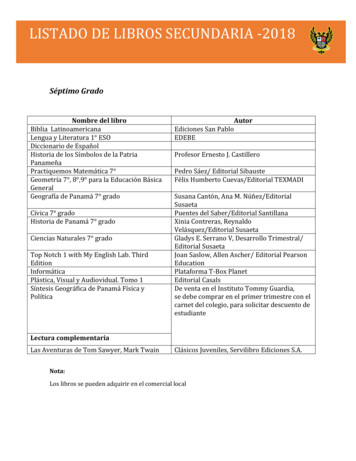
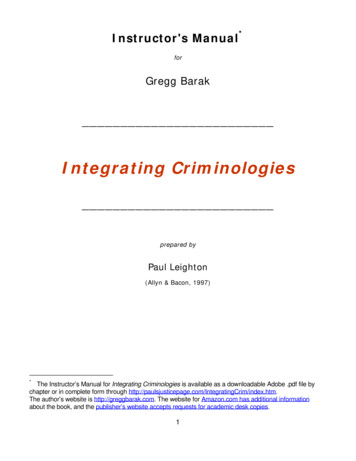


![[MS-XLSX]: Excel (.xlsx) Extensions to the Office Open XML .](/img/31/ms-xlsx.jpg)
